
side effects of cornstarch on hair
Share
The beauty industry is always buzzing with DIY hair treatments and home remedies. Among them, cornstarch is often touted as an inexpensive and natural hair mask ingredient. While it's known for its thickening properties in cooking, its usage in hair care has received mixed reviews. In this article, we will explore the potential benefits and side effects of using cornstarch as a hair treatment.
Understanding Cornstarch Hair Treatments
Cornstarch, or cornflour, is derived from the endosperm of corn kernels. It's mainly composed of carbohydrates and has a powdery texture. When it comes to hair care, cornstarch is praised for its ability to absorb oil, making it a popular ingredient in DIY dry shampoos. It's also used to create a hair mask aimed at smoothing frizz and adding a silky feel to the hair.
Hair Mask Application
To use cornstarch as a hair mask, it's typically mixed with water to form a paste and then applied to the hair. Some recipes also include other ingredients like honey or coconut oil to enhance the treatment's moisturizing effects.
by Vladislav Muslakov (https://unsplash.com/@entersge)
Potential Benefits of Cornstarch
Cornstarch hair treatments can offer several benefits, including:
- Oil Absorption: Ideal for those with oily scalps, cornstarch can absorb excess oil without stripping away natural moisture.
- Smoothing Effect: When used in a hair mask, cornstarch can help to smooth hair strands, potentially reducing frizz and making hair more manageable.
- Cost-Effective: Cornstarch is a budget-friendly alternative to many commercial hair products.
Side Effects to Consider
Despite these potential benefits, there are several side effects associated with using cornstarch on hair:
- Dryness: Cornstarch can overly dry the hair, especially when used in excess or on hair that is already dry or brittle.
- Buildup: Over time, cornstarch can build up on the scalp and hair, leading to clogged pores and dull-looking strands.
- Allergies: Some individuals may be allergic to cornstarch, which can lead to scalp irritation or allergic reactions.
by Gustavo Spindula (https://unsplash.com/@gspindula)
Mitigating the Side Effects
To minimize the potential side effects, it's crucial to use cornstarch sparingly and in combination with moisturizing ingredients. It's also important to thoroughly rinse the hair after treatment to prevent buildup.
Conclusion
Cornstarch can offer a natural and economical alternative for a hair mask or as a dry shampoo. However, it's essential to be aware of its side effects, such as dryness and buildup. If you decide to use cornstarch as part of your hair care routine, do so with caution and pay attention to how your hair and scalp respond. Should you experience any adverse effects, it's best to discontinue use and consult a professional hairstylist or dermatologist.
Remember, every hair type is unique, and what works for one person may not work for another. It's always a good idea to patch test any new hair treatment to ensure it suits your specific needs.


